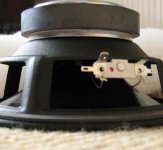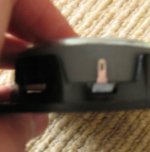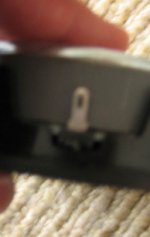I'm sure this is a dumb question, but thought I'd better check first:
I'm just putting together a kit from wilmslow audio which uses a peerless 811815 treble unit and a peerless 850812 mid/bass unit. I have soldered the connections on the x-over fine (decent instructions) but before I make the connections to the drive units I wanted to check I was doing it the right way.
The bass unit looks reasonably straightforward - it has a red dot near one of the terminals, so I assume this is the positive connector.
On the treble there is less to see, but there does seem to be a whitish mark near on post on each unit, is this positive as well?
Here's some pictures to help clarify:
I'm just putting together a kit from wilmslow audio which uses a peerless 811815 treble unit and a peerless 850812 mid/bass unit. I have soldered the connections on the x-over fine (decent instructions) but before I make the connections to the drive units I wanted to check I was doing it the right way.
The bass unit looks reasonably straightforward - it has a red dot near one of the terminals, so I assume this is the positive connector.
On the treble there is less to see, but there does seem to be a whitish mark near on post on each unit, is this positive as well?
Here's some pictures to help clarify:
Attachments
You can easily check the polarity of the bass by applying 1 V DC to the terminals and watch the movement of the driver. If the Red dot is positive compared to the other terminal and, the drivers cone moves out, you have the polarity right.
Not sure about the tweeter
Look here for more information www.d-s-t.com
\Jens
Not sure about the tweeter
Look here for more information www.d-s-t.com
\Jens
Usually a marking will indicate a positive connection with drive units. It would be unusual I think to denote a connection as negative, usually when this is done both terminals are marked. All I can say do is try and see, use the white as positive and see how it sounds. Im assuming these come with bi wire teminals so it wouldnt be too hard to swap the polarity of the tweeter and see which way you prefer it. I would say though that the white is probably +ve.
thanks for the replies guys, that's what I thought really. I'll give it a go. I'm assuming that if I get one driver out of phase with the other it'll be obvious when I try it?
thanks
Owain
thanks
Owain
Actually, for odd order filters, both might give a flat response on-axis. Loobing will be different though. If you have a microphone you could try to feed impulses from a computer and look att the waveform from both the tweeter and woofer to see the polarity of the impulses (haven't tried it myself, but it could work).
- Status
- Not open for further replies.
- Home
- Loudspeakers
- Multi-Way
- polarity of peerless drive units


